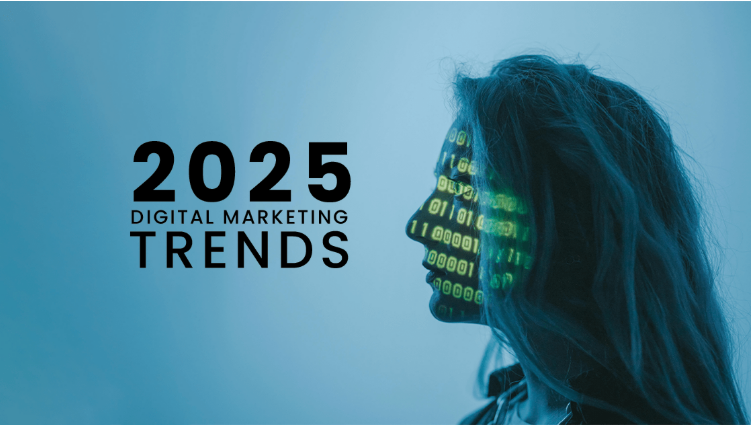Digital marketing in 2025 is evolving faster than ever, driven by rapid advances in technology, shifting consumer expectations, and tighter privacy regulations. What worked a year ago may no longer be enough to capture attention or build loyalty today. From AI-powered content creation to hyper-personalized customer experiences, brands are rethinking how they connect with audiences in an increasingly competitive digital landscape.

This article explores the top digital marketing trends for 2025—the strategies and innovations shaping the future of online engagement. Whether you’re a business owner, marketer, or content creator, staying ahead of these trends will be key to standing out, driving growth, and building meaningful customer relationships in the years to come.
The Rise of AI-Generated Content
Artificial intelligence is transforming the way brands create and distribute content. In 2025, AI tools are no longer just assistants—they have become essential partners for marketers, helping generate blog posts, social media captions, video scripts, and even personalized product descriptions in seconds. This not only saves time but also allows companies to scale their marketing efforts while maintaining consistency across multiple platforms.
However, the real power of AI-generated content lies in its ability to adapt to audience behavior. Modern AI systems analyze user data, search trends, and engagement patterns to produce content that feels relevant and timely. For example, an online gaming brand can combine AI-driven copy with interactive formats, such as reviews of popular games like plinko 1xbet, to capture attention while keeping messaging aligned with audience interests.
Still, businesses must strike the right balance—AI can handle efficiency and scale, but human creativity is what ensures authenticity and emotional connection. The winning strategy in 2025 is blending both, creating content that is smart, engaging, and uniquely human.
Voice and Visual Search Optimization
As technology evolves, consumers are increasingly using voice and visual search to find products, services, and information. With smart speakers, digital assistants, and mobile voice commands becoming part of everyday life, optimizing content for voice search is no longer optional—it’s essential. Voice searches are often conversational and question-based, meaning marketers need to focus on natural language, long-tail keywords, and concise answers to meet user intent.
Visual search is also gaining momentum. Platforms like Google Lens, Pinterest, and TikTok now allow users to search using images instead of text, opening new opportunities for brands to engage customers. From product recognition to style recommendations, visual search can drive traffic and increase conversions in ways traditional search cannot.
For businesses in competitive sectors like online gaming, optimizing for these search formats can make a noticeable difference. By integrating voice-friendly content and high-quality visual assets, brands can stand out in search results and attract a more engaged audience. For instance, players looking for experiences like 1xbet online can find the right games, guides, or promotions more easily when websites are optimized for voice and visual queries.
Staying ahead in 2025 means embracing these technologies, ensuring your content is discoverable in the ways consumers now prefer to search.
Short-Form Video and Interactive Content
Short-form video has become one of the most powerful tools in digital marketing. Platforms like TikTok, Instagram Reels, and YouTube Shorts have shown that attention spans are shrinking, but engagement opportunities are skyrocketing. These videos are concise, visually engaging, and easy to share, making them ideal for capturing audiences quickly and leaving a lasting impression.

Interactive content is taking this a step further. Polls, quizzes, AR filters, and gamified experiences invite users to actively participate rather than passively consume. This not only boosts engagement but also provides valuable insights into audience preferences and behaviors, allowing marketers to refine their strategies in real-time.
Brands leveraging short-form and interactive content can tell stories in creative, memorable ways. For example, gaming companies can use quick tutorials, highlight reels, or mini-game demos to attract players, while encouraging them to interact and share their experiences. The combination of bite-sized storytelling and interactivity ensures higher retention, stronger brand loyalty, and more opportunities for conversion in 2025.
Privacy-First Marketing
With increasing consumer awareness and stricter regulations like GDPR, CCPA, and emerging global privacy laws, privacy-first marketing is no longer optional—it’s a necessity. Brands in 2025 must prioritize user data protection while still delivering personalized and relevant experiences. Consumers are more likely to trust and engage with companies that handle their data transparently and responsibly.
This approach requires a shift from third-party tracking to first-party data strategies. By collecting data directly from users—through subscriptions, interactions, and on-site behavior—brands can create personalized campaigns without compromising privacy. AI and analytics tools can then analyze this first-party data to deliver insights and recommendations, helping marketers optimize messaging and target audiences more effectively.
Privacy-first marketing also strengthens customer relationships. When users feel their information is respected, they are more likely to engage with content, respond to offers, and stay loyal to the brand. In a competitive digital landscape, companies that adopt transparent, ethical, and privacy-conscious strategies will not only comply with regulations but also gain a significant trust advantage over their competitors.




